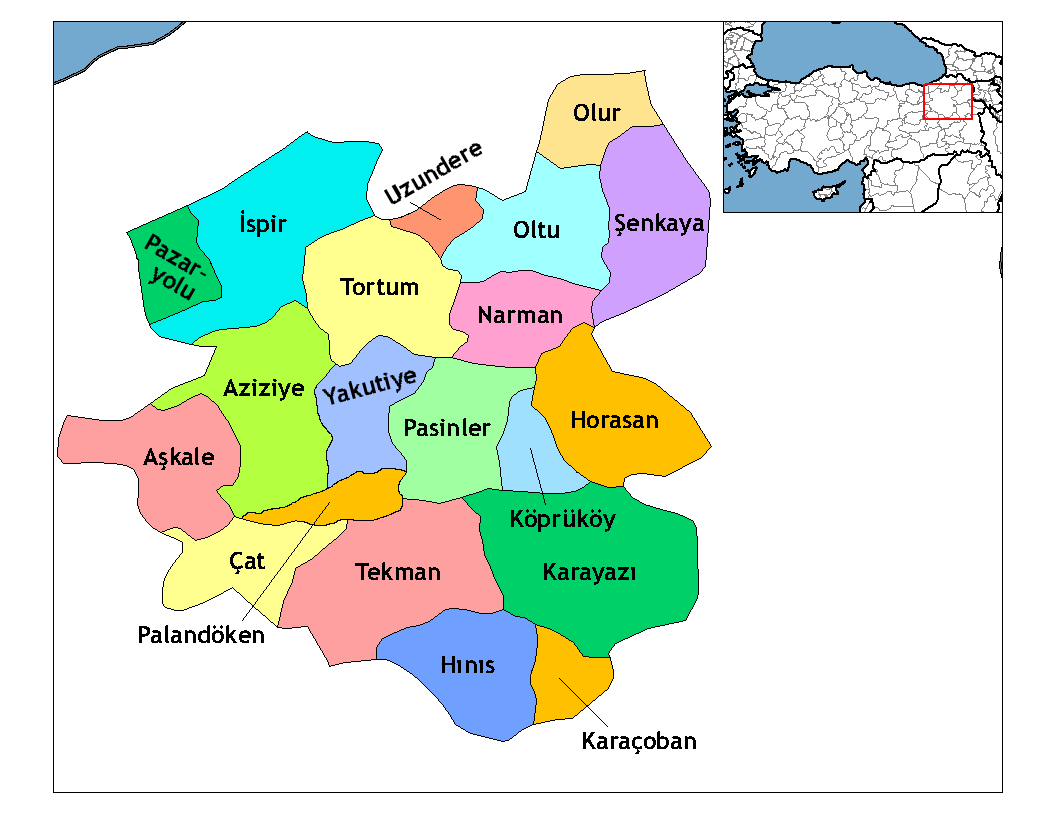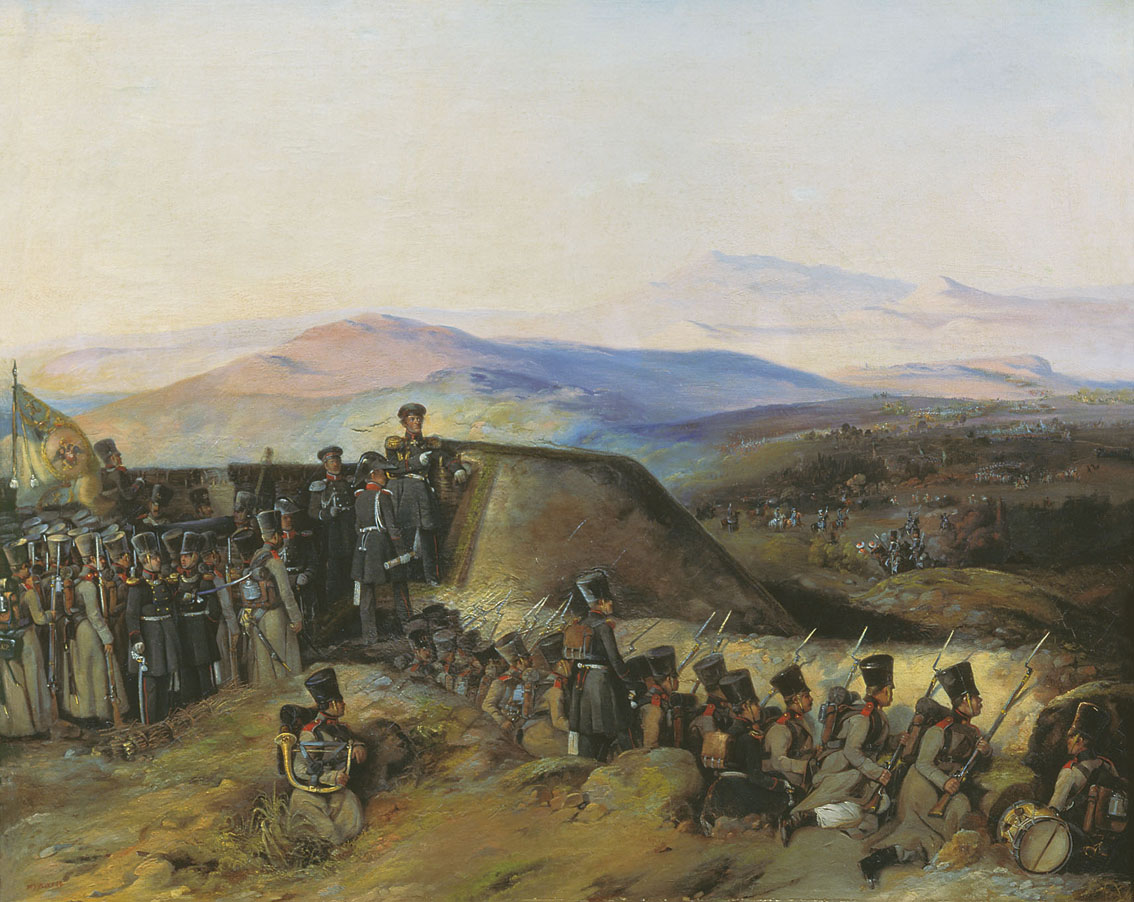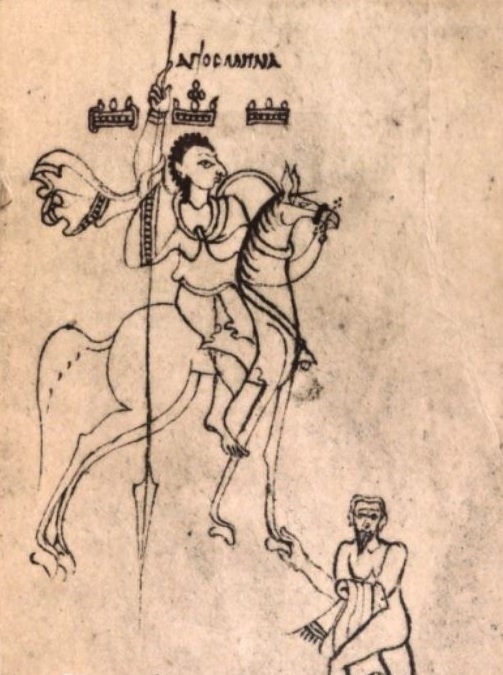|
Monastery Of Saint Minas Of Kes
The Monastery of Saint Minas is a former Armenian monastery in eastern Turkey which has been in use until the Armenian genocide. It's a dome-less basilica with columns (very common for Armenian churches constructed in the 19th century). Located at the western edge of Gezköy village of Erzurum province in Turkey now. The village of Gezköy (formerly known as "Kes") is about 9 km west of the centre of the city of Erzurum. Etymology Saint Minas the Martyr and Thaumaturgy is one of the saints of the Armenian-Gregorian church that corresponds to Saint Minas in the other Christian churches. Toponym "Kes" () in Armenian is for "half", which was a former (historical) name of the village of Gezköy, which in Turkish means "eye-village". History At the begin of the 19th century there were some 100 Armenian-populated villages in the Erzurum plain - by the end of the century that number had been reduced to around 50. The brief Russian liberation of parts from the Ottoman Emp ... [...More Info...] [...Related Items...] OR: [Wikipedia] [Google] [Baidu] |
Erzurum Province
Erzurum Province () is a province and metropolitan municipality in the Eastern Anatolia Region of Turkey. Its area is 25,006 km2, and its population is 749,754 (2022). The capital of the province is the city of Erzurum. It is the fourth largest province in all of Turkey. It is bordered by the provinces of Kars and Ağrı to the east, Muş and Bingöl to the south, Erzincan and Bayburt to the west, Rize and Artvin to the north and Ardahan to the northeast. The governor of the province is Mustafa Çiftçi, appointed in August 2023. The province has a Turkish majority. Geography The surface area of the province of Erzurum is the fourth biggest in Turkey. The majority of the province is elevated. Most plateaus are about above sea level, and the mountainous regions beyond the plateaus are and higher. Depression plains are located between the mountains and plateaus. The southern mountain ranges include the Palandöken Mountains (highest peak Büyük Ejder high) and t ... [...More Info...] [...Related Items...] OR: [Wikipedia] [Google] [Baidu] |
Thaumaturgy
Thaumaturgy () is the practical application of magic to effect change in the physical world. Historically, thaumaturgy has been associated with the manipulation of natural forces, the creation of wonders, and the performance of magical feats through esoteric knowledge and ritual practice. Unlike theurgy, which focuses on invoking divine powers, thaumaturgy is more concerned with utilizing occult principles to achieve specific outcomes, often in a tangible and observable manner. It is sometimes translated into English as wonderworking. This concept has evolved from its ancient roots in magical traditions to its incorporation into modern Western esotericism. Thaumaturgy has been practiced by individuals seeking to exert influence over the material world through both subtle and overt magical means. It has played a significant role in the development of magical systems, particularly those that emphasize the practical aspects of esoteric work. In modern times, thaumaturgy continue ... [...More Info...] [...Related Items...] OR: [Wikipedia] [Google] [Baidu] |
Khatchkar
A ''khachkar'' (also spelled as ''khatchkar'') or Armenian cross-stone (, , խաչ ''xačʿ'' "cross" + քար ''kʿar'' "stone") is a carved, memorial stele bearing a cross, and often with additional motifs such as rosettes, interlaces, and botanical motifs. ''Khachkars'' are characteristic of medieval Christian Armenian art.The Grove Encyclopedia of Medieval Art and Architecture. — Oxford University Press, 2012. — Vol. 2. — P. 222.''"'Khatck'ar' rmen.:'cross-stone'Typical Armenian stone monument, comprising an upright slab (h. c. 1—3 m) carved with a cross design, usually set on a plinth or rectangular base. "'' Since 2010, khachkars, their symbolism and craftsmanship are inscribed in the UNESCO list of Intangible Cultural Heritage. Description The most common ''khachkar'' feature is a cross surmounting a rosette or a solar disc. The remainder of the stone face is typically filled with elaborate patterns of leaves, grapes, pomegranates, and bands of interlace ... [...More Info...] [...Related Items...] OR: [Wikipedia] [Google] [Baidu] |
Crimean War
The Crimean War was fought between the Russian Empire and an alliance of the Ottoman Empire, the Second French Empire, the United Kingdom of Great Britain and Ireland, and the Kingdom of Sardinia (1720–1861), Kingdom of Sardinia-Piedmont from October 1853 to February 1856. Geopolitical causes of the war included the "Eastern question" (Decline and modernization of the Ottoman Empire, the decline of the Ottoman Empire, the "sick man of Europe"), expansion of Imperial Russia in the preceding Russo-Turkish wars, and the British and French preference to preserve the Ottoman Empire to maintain the European balance of power, balance of power in the Concert of Europe. The flashpoint was a dispute between France and Russia over the rights of Catholic Church, Catholic and Eastern Orthodox Church, Orthodox minorities in Palestine (region), Palestine. After the Sublime Porte refused Nicholas I of Russia, Tsar Nicholas I's demand that the Empire's Orthodox subjects were to be placed unde ... [...More Info...] [...Related Items...] OR: [Wikipedia] [Google] [Baidu] |
Russo-Turkish War (1828–1829)
The Russo-Turkish War of 1828–1829 resulted from the Greek War of Independence of 1821–1829; war broke out after the Ottoman Sultan Mahmud II closed the Dardanelles to Russian Empire , Russian ships and in November 1827 revoked the 1826 Akkerman Convention in retaliation for the participation of the Imperial Russian Navy in the Battle of Navarino of October 1827. After suffering several defeats, both in the Balkans and in the Caucasus, the Sultan decided to suing for peace, sue for peace, which resulted in the signing of the Treaty of Adrianople (1829), Treaty of Adrianople on 14 September 1829. The Balkan front At the start of hostilities the Russian army of 100,000 men was commanded by Emperor Nicholas I of Russia, Nicholas I, while the Ottoman forces were commanded by Agha Hüseyin Pasha appointed by Sultan Mahmut II. In April and May 1828 the Russian commander-in-chief, Prince Peter Wittgenstein, moved into the Danubian Principalities. In June 1828, the main R ... [...More Info...] [...Related Items...] OR: [Wikipedia] [Google] [Baidu] |
Turkish Language
Turkish ( , , also known as 'Turkish of Turkey') is the most widely spoken of the Turkic languages, a member of Oghuz languages, Oghuz branch with around 90 million speakers. It is the national language of Turkey and one of two official languages of Cyprus. Significant smaller groups of Turkish speakers also exist in Germany, Austria, Bulgaria, North Macedonia, Greece, other parts of Europe, the South Caucasus, and some parts of Central Asia, Iraqi Turkmen, Iraq, and Syrian Turkmen, Syria. Turkish is the List of languages by total number of speakers, 18th-most spoken language in the world. To the west, the influence of Ottoman Turkish language, Ottoman Turkish—the variety of the Turkish language that was used as the administrative and literary language of the Ottoman Empire—spread as the Ottoman Empire expanded. In 1928, as one of Atatürk's reforms in the early years of the Republic of Turkey, the Persian alphabet, Perso-Arabic script-based Ottoman Turkish alphabet was repl ... [...More Info...] [...Related Items...] OR: [Wikipedia] [Google] [Baidu] |
Armenian Language
Armenian (endonym: , , ) is an Indo-European languages, Indo-European language and the sole member of the independent branch of the Armenian language family. It is the native language of the Armenians, Armenian people and the official language of Armenia. Historically spoken in the Armenian highlands, today Armenian is also widely spoken throughout the Armenian diaspora. Armenian is written in its own writing system, the Armenian alphabet, introduced in 405 AD by Saint Mesrop Mashtots. The estimated number of Armenian speakers worldwide is between five and seven million. History Classification and origins Armenian is an independent branch of the Indo-European languages. It is of interest to linguists for its distinctive phonological changes within that family. Armenian exhibits Centum and satem languages, more satemization than centumization, although it is not classified as belonging to either of these subgroups. Some linguists tentatively conclude that Armenian, Greek ... [...More Info...] [...Related Items...] OR: [Wikipedia] [Google] [Baidu] |
Christianity
Christianity is an Abrahamic monotheistic religion, which states that Jesus in Christianity, Jesus is the Son of God (Christianity), Son of God and Resurrection of Jesus, rose from the dead after his Crucifixion of Jesus, crucifixion, whose coming as the Messiah#Christianity, messiah (Christ (title), Christ) was Old Testament messianic prophecies quoted in the New Testament, prophesied in the Old Testament and chronicled in the New Testament. It is the Major religious groups, world's largest and most widespread religion with over 2.3 billion followers, comprising around 28.8% of the world population. Its adherents, known as Christians, are estimated to make up a majority of the population in Christianity by country, 157 countries and territories. Christianity remains Christian culture, culturally diverse in its Western Christianity, Western and Eastern Christianity, Eastern branches, and doctrinally diverse concerning Justification (theology), justification and the natur ... [...More Info...] [...Related Items...] OR: [Wikipedia] [Google] [Baidu] |
Saint Minas
Menas of Egypt (also Mina, Minas, Mena, Meena; ; ; 285 – c. 309), a martyr and wonder-worker, is one of the most well-known Coptic saints in the East and the West, due to the many miracles that are attributed to his intercession and prayers. Menas was a Coptic soldier in the Roman army martyred because he refused to recant his Christian faith. The common date of his commemoration is November 11, which occurs 13 days later (November 24) on the Julian calendar. His feast day is celebrated every year on 15 Hathor in the Coptic Orthodox Church of Alexandria, which corresponds to November 24 on the Gregorian Calendar. In Eastern Orthodox churches that follow the old style or Julian calendar, it is likewise celebrated on November 24. In the Eastern Orthodox churches that follow the new style or Revised Julian calendar, as well as in the Catholic Church, it is celebrated on November 11. Origin of his name Menas was his original name, according to the story his mother called him "M� ... [...More Info...] [...Related Items...] OR: [Wikipedia] [Google] [Baidu] |
Saint
In Christianity, Christian belief, a saint is a person who is recognized as having an exceptional degree of sanctification in Christianity, holiness, imitation of God, likeness, or closeness to God in Christianity, God. However, the use of the term ''saint'' depends on the context and Christian denomination, denomination. In Anglican Communion, Anglican, Oriental Orthodox, and Lutheranism, Lutheran doctrine, all of their faithful deceased in Heaven are considered to be saints, but a selected few are considered worthy of greater honor or emulation. Official Ecclesiastical polity, ecclesiastical recognition, and veneration, is conferred on some denominational saints through the process of canonization in the Catholic Church or glorification in the Eastern Orthodox Church after their approval. In many Protestant denominations, and following from Pauline usage, ''saint'' refers broadly to any holy Christian, without special recognition or selection. While the English word ''saint'' ... [...More Info...] [...Related Items...] OR: [Wikipedia] [Google] [Baidu] |
Martyr
A martyr (, ''mártys'', 'witness' Word stem, stem , ''martyr-'') is someone who suffers persecution and death for advocating, renouncing, or refusing to renounce or advocate, a religious belief or other cause as demanded by an external party. In colloquial usage, the term can also refer to any person who suffers a significant consequence in protest or support of a cause. In the martyrdom narrative of the remembering community, this refusal to comply with the presented demands results in the punishment or execution of an individual by an oppressor. Accordingly, the status of the 'martyr' can be considered a posthumous title as a reward for those who are considered worthy of the concept of martyrdom by the living, regardless of any attempts by the deceased to control how they will be remembered in advance. Insofar, the martyr is a relational figure of a society's boundary work that is produced by collective memory. Originally applied only to those who suffered for their religious b ... [...More Info...] [...Related Items...] OR: [Wikipedia] [Google] [Baidu] |
Armenian Apostolic Church
The Armenian Apostolic Church () is the Autocephaly, autocephalous national church of Armenia. Part of Oriental Orthodoxy, it is one of the most ancient Christianity, Christian churches. The Armenian Apostolic Church, like the Armenian Catholic Church, belongs to the Armenian Rite. The Kingdom of Armenia (antiquity), Kingdom of Armenia was the first state in history to adopt Christianity as its official religion (under the Armenian Apostolic traditions) during the rule of Tiridates III of Armenia, King Tiridates III, of the Arsacid dynasty of Armenia, Arsacid dynasty in the early 4th century. According to tradition, the church originated in the missions of Apostles Bartholomew the Apostle, Bartholomew and Jude the Apostle, Thaddeus (Jude) in the 1st century. St. Gregory the Illuminator was the first official primate (bishop), primate of the church. It is sometimes referred to as the Armenian Apostolic Orthodox Church, Armenian Church or Armenian Gregorian Church. The Armenian Ap ... [...More Info...] [...Related Items...] OR: [Wikipedia] [Google] [Baidu] |







